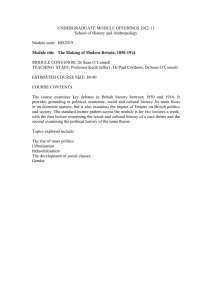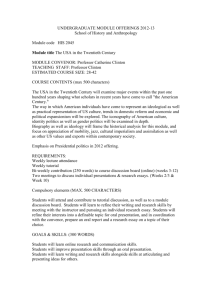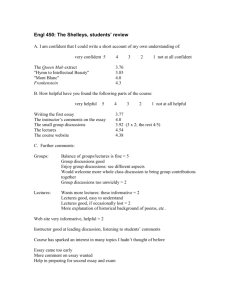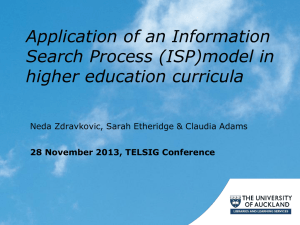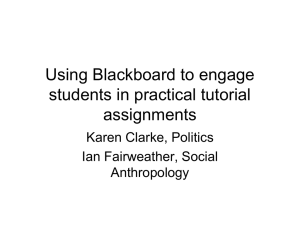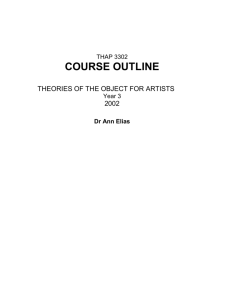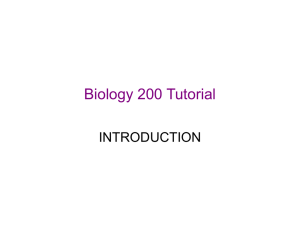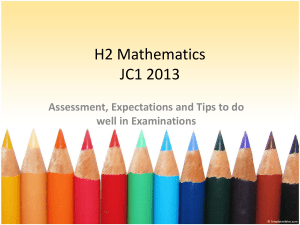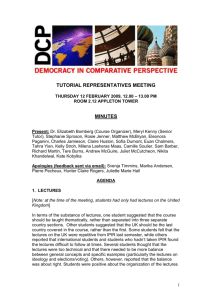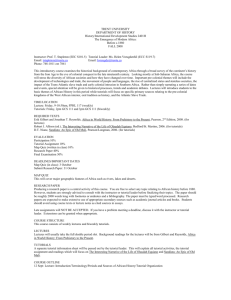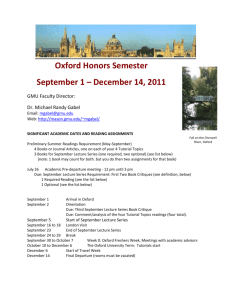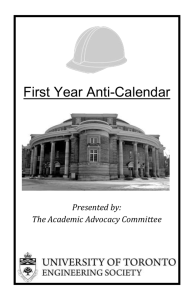Level 1: Transition and Skills
advertisement
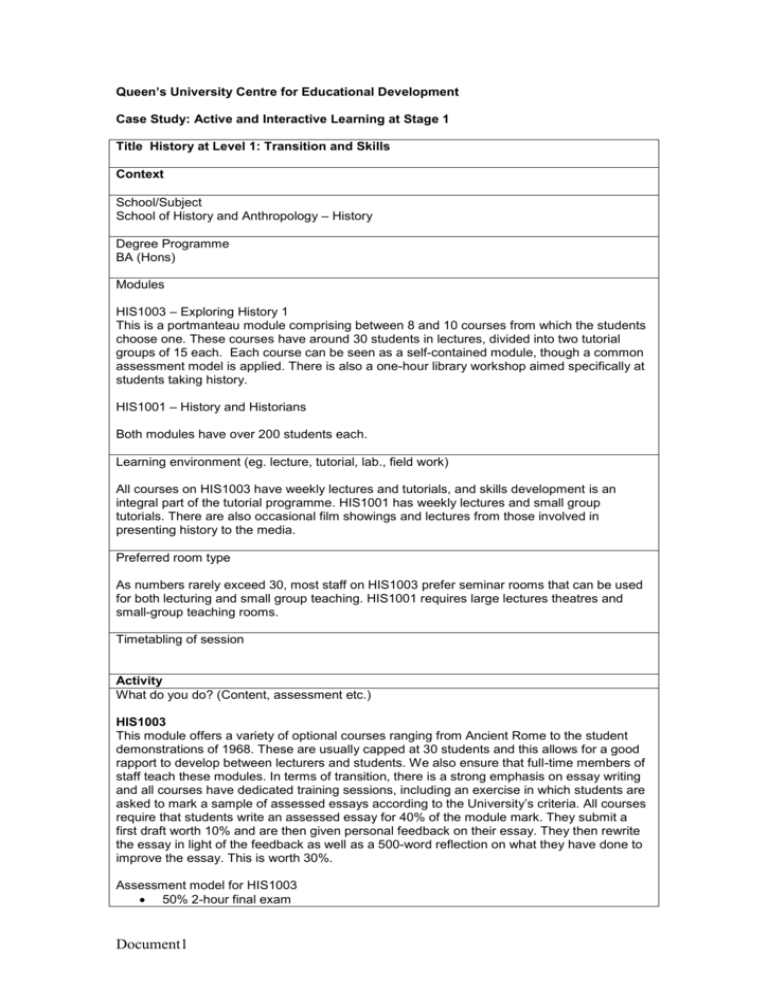
Queen’s University Centre for Educational Development Case Study: Active and Interactive Learning at Stage 1 Title History at Level 1: Transition and Skills Context School/Subject School of History and Anthropology – History Degree Programme BA (Hons) Modules HIS1003 – Exploring History 1 This is a portmanteau module comprising between 8 and 10 courses from which the students choose one. These courses have around 30 students in lectures, divided into two tutorial groups of 15 each. Each course can be seen as a self-contained module, though a common assessment model is applied. There is also a one-hour library workshop aimed specifically at students taking history. HIS1001 – History and Historians Both modules have over 200 students each. Learning environment (eg. lecture, tutorial, lab., field work) All courses on HIS1003 have weekly lectures and tutorials, and skills development is an integral part of the tutorial programme. HIS1001 has weekly lectures and small group tutorials. There are also occasional film showings and lectures from those involved in presenting history to the media. Preferred room type As numbers rarely exceed 30, most staff on HIS1003 prefer seminar rooms that can be used for both lecturing and small group teaching. HIS1001 requires large lectures theatres and small-group teaching rooms. Timetabling of session Activity What do you do? (Content, assessment etc.) HIS1003 This module offers a variety of optional courses ranging from Ancient Rome to the student demonstrations of 1968. These are usually capped at 30 students and this allows for a good rapport to develop between lecturers and students. We also ensure that full-time members of staff teach these modules. In terms of transition, there is a strong emphasis on essay writing and all courses have dedicated training sessions, including an exercise in which students are asked to mark a sample of assessed essays according to the University’s criteria. All courses require that students write an assessed essay for 40% of the module mark. They submit a first draft worth 10% and are then given personal feedback on their essay. They then rewrite the essay in light of the feedback as well as a 500-word reflection on what they have done to improve the essay. This is worth 30%. Assessment model for HIS1003 50% 2-hour final exam Document1 40% Assessed Essay 10% Tutorial contribution HIS1001 This module seeks to engage students with important debates about historical truth and ‘contested pasts’. Students learn to engage with and discuss potentially sensitive issues, such as the crusades, slavery, and genocide, in a respectful and thoughtful manner. They explore the assumptions made about these notable historical topics and develop a more sophisticated and empathetic approach to the debates. A significant aspect of the module explores how history is presented to the public through media such as museum exhibitions, websites, and documentaries. Students examine the potential opportunities and problems involved with presenting controversial historical topics to a popular audience. In researching and presenting their ideas, they are encouraged to develop their teamwork and communication skills. The first part of the module is based around a series of lectures (two one-hour lectures per week) and two-hour tutorials, in which certain themes and topics are discussed. Contact hours are relatively high, reflecting the new types of materials and historiographical approaches. HIS1001 also brings in numerous guest lecturers from museums, documentarymaking firms and popular history in order to introduce students to broader ways of thinking about history and the media. In addition, primary source material and examples of ‘public history’ are provided for the weekly tutorial so that specific historical issues can be examined in depth. Discussions are based around lectures, specified reading, online tutorial journals, primary sources, and examples of public history. The second part of the module provides an opportunity for students, in groups, to develop a ‘public history’ project proposal and a formal presentation. Students also explore broader issues regarding the concept and reception of history. Assessment model for HIS1003 40% Tutorial journal 15% Assessed Essay 30% Public history group project proposal 15% Group presentation How do you do it? (method including tips) The School’s policy is that students should receive 30 hours of contact time per module per semester. Some courses on HIS1003 have a weekly lecture and tutorial, as well as longer workshops at specific times in the semester to concentrate on essay writing skills. Small group work, including working in pairs, is usually employed in tutorials. Why do you do it that way? HIS1003 is designed to provide students with a stimulating first experience of historical study at university level and to bridge the transition from a regimented A-Level system to the relative freedom of third-level study. Full-time members of staff teach these courses in order to engage students from the outset. HIS1001 is designed to introduce students to public history and the relationship between academic research and public life. It also has a strong skills component in terms of developing group work and presentation skills Technology (if any) used to support activity (brief description) Queen’s Online (QOL) is used extensively in both modules to provide resources and feedback, as well as acting as a means of assessment. In HIS1001 there are also opportunities for online discussion forums around certain debates, and these forums Document1 are also used by student groups when preparing their group projects. Resources: every member of staff uploads readings to QOL as well as course documents and PowerPoint slides. The readings must be scanned by the Library and have the appropriate copyright notice Feedback: Both modules follow the School’s policy on feedback. All students are automatically given feedback on all assessment through QOL, including the HIS1003 exam. The final mark for HIS1001 is based on continuous assessment and feedback is given on the tutorial journals, assessed essays, and group presentation. Means of assessment: In HIS1001, the weekly tutorial journal that the students complete is worth 40% of the final mark and is completed online via QOL. PowerPoint is almost universally used. One member of staff teaching on HIS1003 has employed the Personal Response System in class to engage students. Evaluation/Reflection/Outcomes How do you know it works? (measures you adopted, student feedback outcomes, staff feedback) HIS1001 received a teaching award from the University. Feedback from student questionnaires for both modules is generally very positive and students certainly value the level of feedback they get in HIS1003. Challenges/Issues/Problems include: The legacy of an A-Level system that tends to spoon-feed students and seems only to equip them to sit an exam rather than think for themselves. Getting students to see the relevance and value of group work on HIS1001 Sustaining student enthusiasm during the transition from level 1 to level 2. Advice and Tips Make sure that you know the type of education your first-year students received at school. Level 1 has to be about educating students in a very different way of learning. It is not their fault that many find the transition to university difficult. Looking forward Support Material (please upload/attach or give URL) References (if available) Contact Details HIS1003: Dr Andrew Holmes a.holmes@qub.ac.uk HIS1001: Dr James Davis james.davis@qub.ac.uk Document1
